
03 9457 4755













HRD Vincent
HRD Vincent
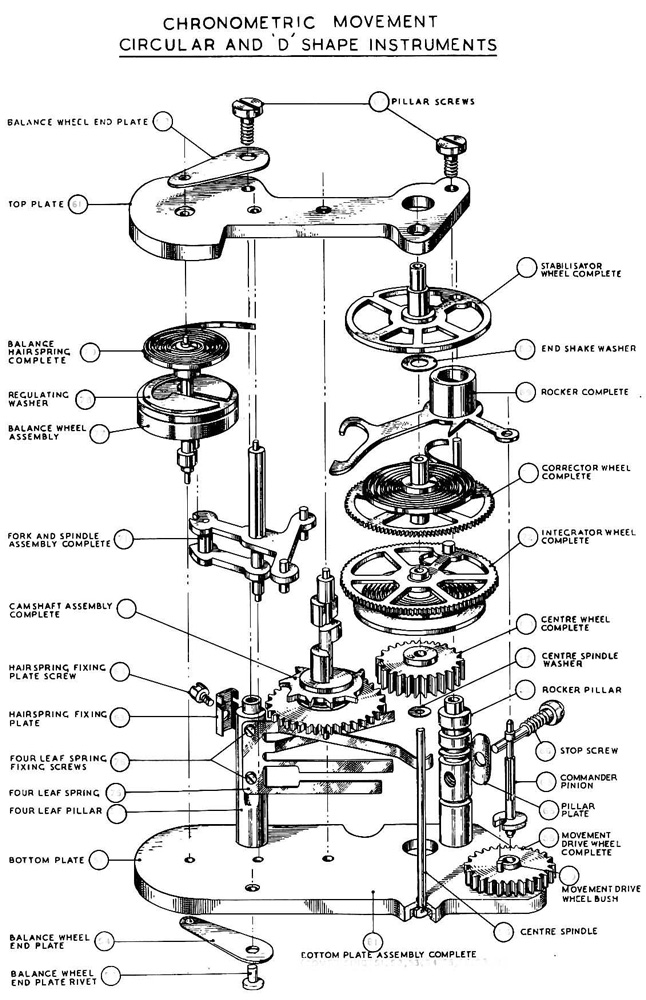
We restore all chronometric speedometer's and tachometer's including maximum hand models.
Vincent Motorcycles used a very broad range of Chronometric Instruments.
![]()
HRD VINCENT SPEEDOMETER DIALS

These dials are the beginning of our HRD range, currently we have 9 different speedometers available across the HRD era.
HRD VINCENT TACHOMETER DIALS

These dials are the beginning of our HRD range, currently we have 3 different tachometers available across the HRD era.
![]()
HRD VINCENT CLOCK DIALS

These dials are the beginning of our HRD range, currently we have 3 different clocks available across the HRD era.
SMITHS GAUGES
.jpg)
Smiths style is timeless. We have the best range of new Smiths Instruments in stock in Australia.
![]()
ANGLE DRIVES

Angle Drives to alter ratio and direction are an integral part of any chronometric installation.
MOREcables

We manufacture any speedometer and tachometer cables to sample or specification. We make some throttle cables and have push-pull cables manufactured to sample or specification.
Moreautomotive chrono's
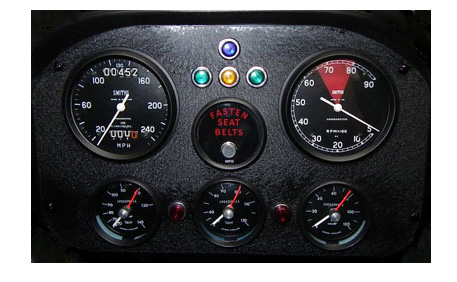
Rodger uses Chronometric instruments in his Marcos.Let us help you install some in your car.
More
![]()
CHRONOMETRIC 250MPH
.jpg)
This speedo was installed in the XJ13 Jaguar Protoype in 1966.Jaguar hoped to win at Lemans but unfortunately the car did not get the opportunity to explore the limits of this unusual scale which normally only extends to 150mph!
CHRONOELECTRIC
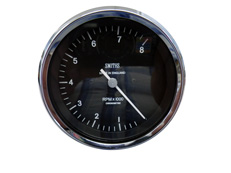
For those of you that cannot apply an original chronometric to your application these Chronoelectric Tachometers offer an affordable alternative with maximum recall option available in 8, 10 or 12000rpm.
dials

We screen print traditional flood lit dials and modern back lit dials.We can print in all colours and finishes including metallic and fluorescents.Our dial library is always increasing.We will design artwork from scratch or modify existing artwork.
More
![]()
The Vincent speedometer by Denis Quinlan the velobanjogent.....
Throughout my various earlier blogs there are references to chronometric speedometers and tachometers and of course I have showcased Phil Irving's involvement with The Vincent Motorcycle.
So perhaps this is the time to post some data of the Smith's instruments and ancillaries used on the Vincent motorcycle.
All the Vincent speedometers used on the 500cc and 1000cc models were Smith's chronometric instruments, including the tachometer on the Black Lightning and Grey Flash racers.
Prewar the cable fitting attached to the speedo via what is called in the instrument trade "a Jaeger fitting". The threaded fitting came during WW2 and used a 12mm x 1mm thread.
Interesting the use of metric threads...but the chronometric is a French Jaeger instrument and thus totally metric.
Left click on the images to enlarge.
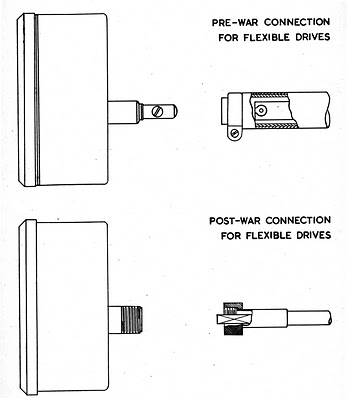
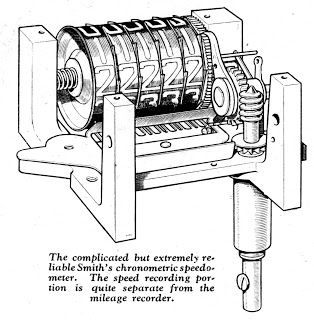
In the 1930's most of the chronometric speedometers supplied to the motorcycle trade were 80mm ( 3") diameter 85mph often Non trip, but otherwise trip and 140kph for metric areas of the world. But some did use 120mph, such as the Rudge Ulster, the BSA Gold Star, Brough Superior and the Vincent "A" twin . I don't have evidence for the single 500cc Meteor, but would be inclined to think it used the 85mph/140kph speedo.
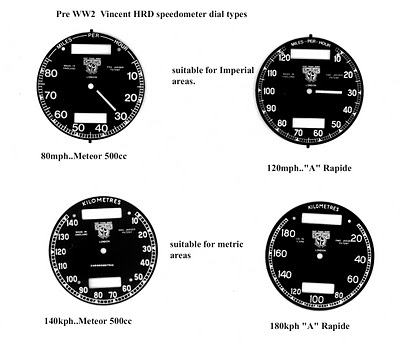
After WW2 the trend for 85mph speedos continued up until around 1949 with many manufacturers, but Vincent-HRD, then just Vincent used the 120mph trip chronometric with side exit trip as the speedo was mounted in the open.
Note above the Smiths logo...we call this the shield logo and it was used up until the mid 1946, when the circular "MA" was removed and the text became SmithS with the "S" at either end in capitals.
From the mid 1950's, but more likely 1959 on, the logo was SMITHS...
.jpg)
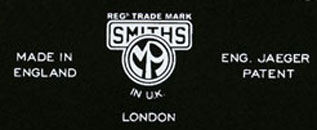
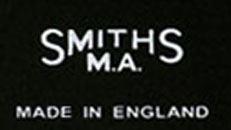
Following WW2 the Vincent-HRD company used the following for the series B and series C Comet and Rapide.
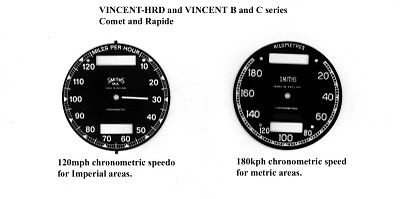
With the imminent introduction of the Black Shadow, PEI recalls on p.365 of his autobiography the need for a 150mph speedo with a 5 inch dial.
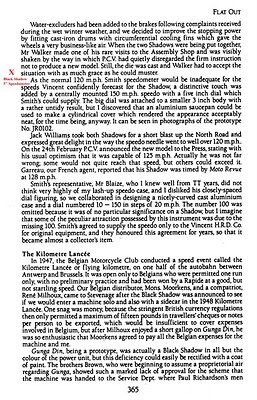
This is one of the available photos that show the prototype speedometer, published in the Australian motorcycle magazine "Motorcycling in Australia"
I do not know how many of this "lashup" of a speedometer were made.
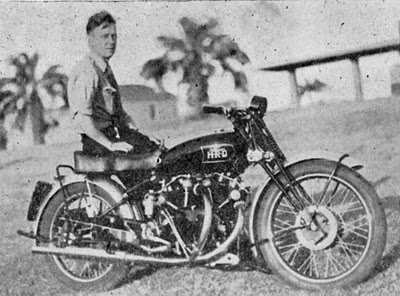
But the cast aluminium version, stove enameled black is a nice looking speedo.
The following are photos of the reproduction that Dennis Quinlan made.
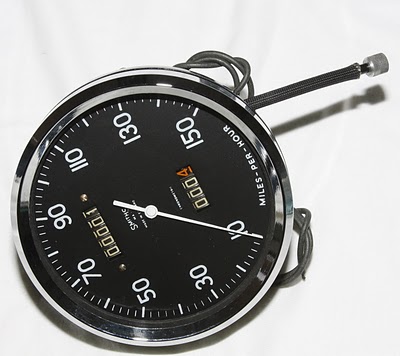
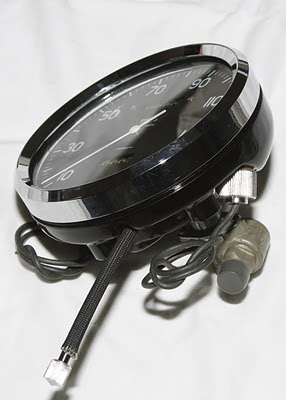
The speedometers were available as 150mph, but in metric areas, a 250kph version was offered.
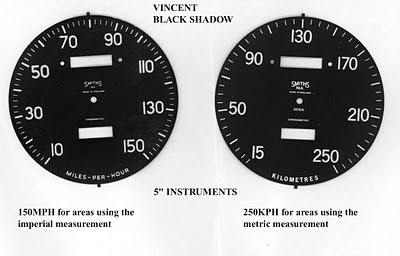
Around the same time a racing version , the Black Lightning, made in very limited numbers was supplied with an 8000rpm 4-1 ratio anti-clockwise cable rotation chronometric tachometer with yellow lettering and some had speedometers...a 18omph 80mm (3") dia. chronometric or a 280kph 80mm (3") chronometric for the minuscule number available for metric areas. Again yellow lettering.
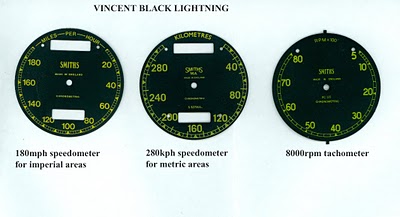
A racing version of the 500cc Vincent Comet, called the Grey Flash was also supplied with an 8000rpm 4-1 anticlockwise Smiths chronometric tachometer and was offered with a 125mph or 180kph speedometer with white numerals.
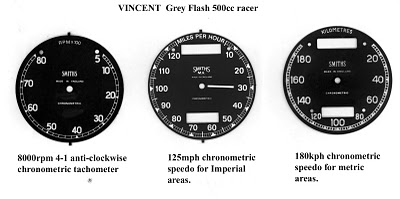
Both the Black Lightning and the Grey Flash used a Smiths bronze casting tachometer drive type 70549 of 2-1 ratio and reversing format.
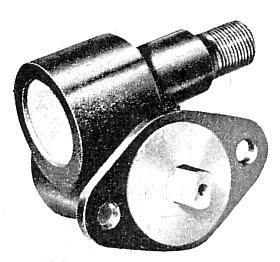
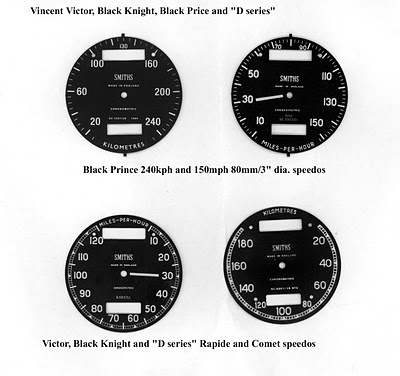
The reason for the special anticlockwise tachometer was that the majority of British motorcycles drove tachometers off their magneto and when you looked at the shaft which the drive gear attached to, it rotated anticlockwise.
Smiths only offered the bronze type 70549 tachometer drives in 1-1 reversing and 2-1 reversing.
So with the Vincent having a clockwise rotating magneto, the use of the 2-1 reversing tachometer drive gave the 4-1 anti-clockwise tachometer requirement.
When the fully enclosed models arrived in the mid 1950's...the Victor, Black Knight, Black Prince the speedometers were all 80mm ( 3") dia. but as they were in a dashboard, they had flanged bezels and and extended reset shaft. The Victor and Knight has 125mph/180kph dials and the Prince 150mph/240kph dials.
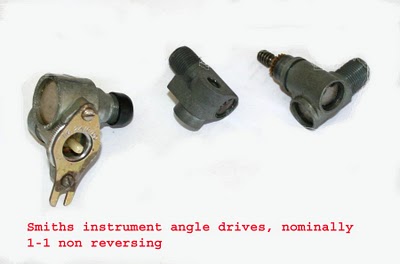
The speedometers had a small angle drive on their back of the same type as the earlier Black Shadow, but with a keyplate and two 4BA screws to secure it to the case.
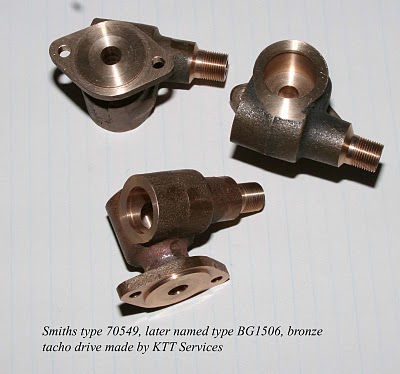
Finally the drive to all the speedometers was from the pre WW2 type front wheel diecast speedometer drive gearbox in the brake plate with the driver gear bolted inside the front hub.
These small diecast drives are 1.5-1 ratio. The large gear was 41 teeth ( same as a Velocette KSS and MSS) . The small driven gear was 13 teeth ( again same as Velocette KSS and MSS) both 12 D.P. tooth form.
The front wheel "nominally" turns 750 times in a mile.
This is calculated as follows....
21" wheel with 3.00 tyre, gives a diameter wheel/tyre diameter of 27".
C=pie x d...3.142 x 27 = 84.8" rolling circumference.
1 mile = 63,360 ".
So 63360/84.8 = approx 750 wheel turns per mile.
The two gears give a 41/13 = 3.15 ratio and the 1.5:1 reduction in the drive gives a total ratio of 2.1:1.
So 2.1 x 750 = 1575 cable turns per mile calibration factor.
Most of the speedometers were available as 1550 to 1600 TPM.
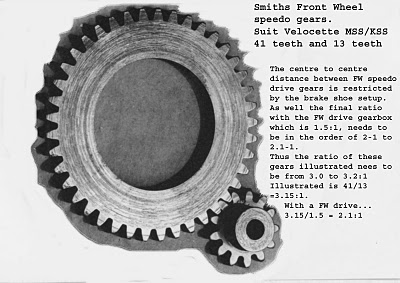
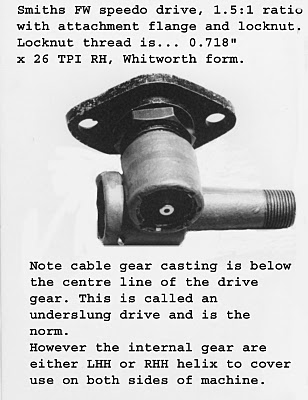
Now I may come back and amend this blog, as it is after midnight as I post it...
The Black Shadow never had a 5" Smiths chronometric tachometer as standard, but some time after the Vincent company went into liquidation and closed after 1955.....5" diameter 8000rpm tachometers in the cast speedometer case became available in limited quantities.
I have have also made them and illustrated below is one , with the bronze type 70549 drive for a customer.
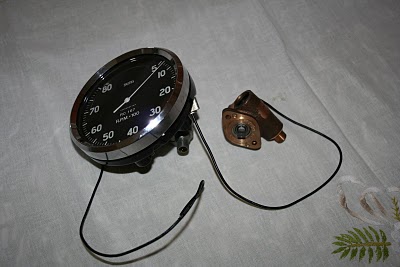
Following are some Smiths Equipment Schedules for Vincent which give instrument, drive and cable information as supplied to the Vincent Company.
Speedometer cable lengths to 1948.
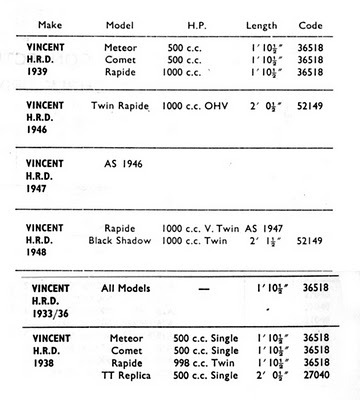
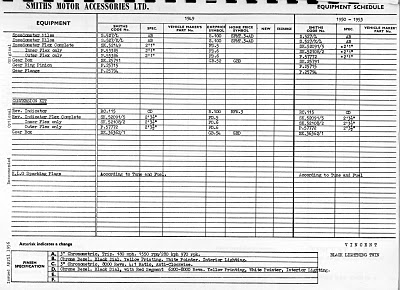
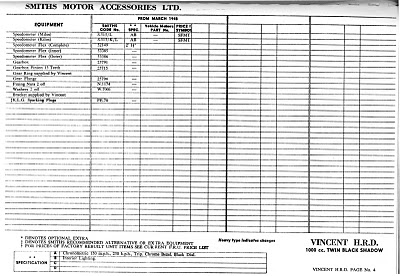
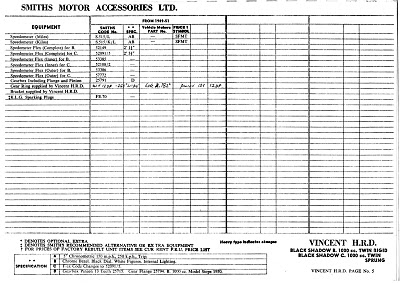
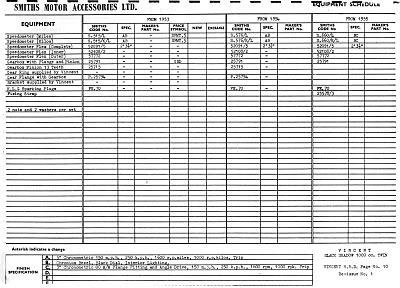
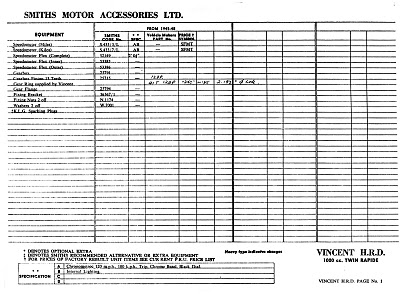
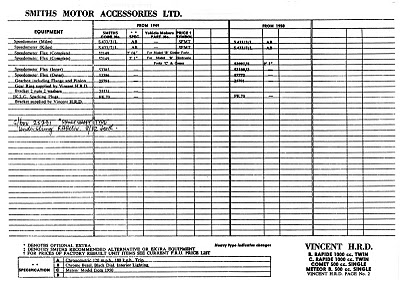
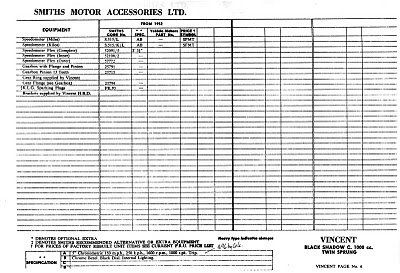
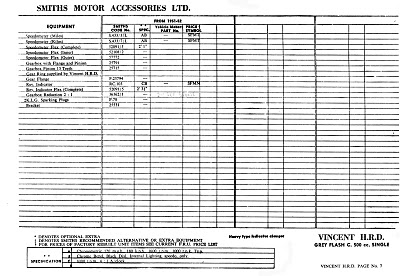
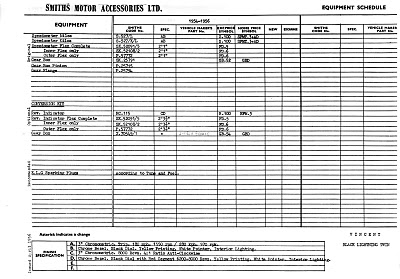
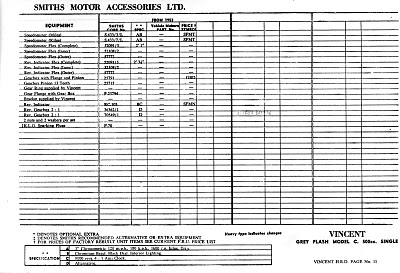
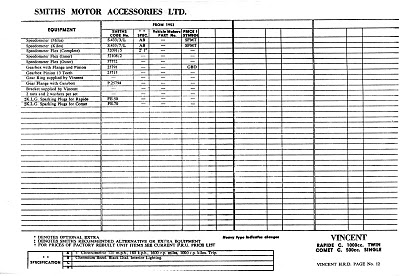
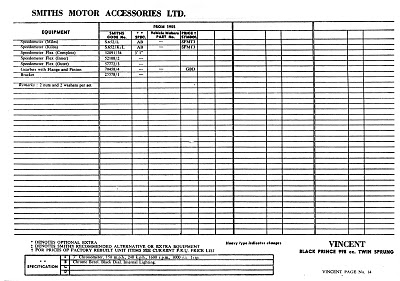
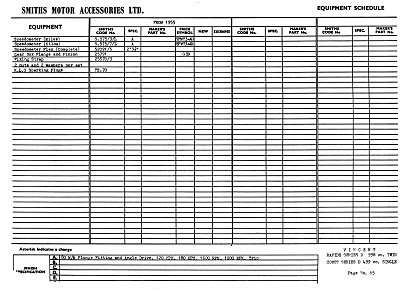
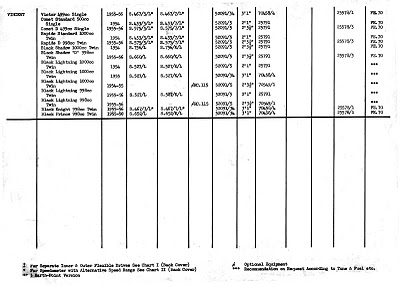
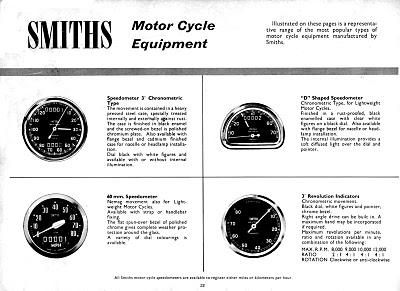
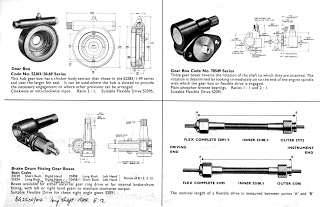
![]()
The Chronometric speedometer is a principle commenced by the Jaeger speedometer company in Paris, France, in the 1920s and as such is a METRIC instrument, that is the dimensions, screws, threads etc. are metric and not imperial as generally thought.
For example on the motorcycle instrument, considered to be 3” dia., with a 26tpi thread, the bezel is 80mm dia. x 0.9mm thread. Sometime in the late 1920's, Jaeger Paris set up a company in England, Jaeger Ed., with two British directors and one French director. Around 1927, Smiths Motor Accessories purchased this company and re-named it British Jaeger.
For a long time the dial faces, either with the British Jaeger or Smiths logo on them also had a credit to Jaeger …”Jaeger patent”. Smith’s often badged their instruments Jaeger or Smiths.
The movement of a chronometric speedometer is strictly an integrating mechanism, the controlling factor being the time base, a conventional ‑ or near conventional-escapement unit as used in every watch and clock mechanism. In this instrument there is no free movement of the pointer since at any instant it is, either rigidly locked in a given position or geared direct to the driving, cable. The escapement is mounted on the left hand side of the movement. The escape wheel is mounted rigidly to a small camshaft and is driven through a spring loaded clutch between it and the driving gear at the base of the shaft. This gear is directly coupled to the speedometer driving cable, and provides the motive power to maintain the oscillations of the escapement. The speed of the camshaft is, of course, maintained at a constant figure according to the timing of the escapement. The clutch is caused to slip when the driving speed exceeds this figure. Next to the camshaft the main wheel assembly is seen. This consists of the three wheels known respectively as the integrator (at the bottom), the recorder wheel (in the centre), and the stabiliser (at the top).
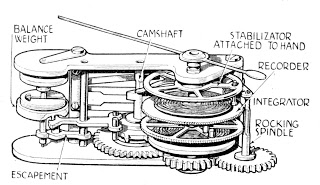
To the last named the pointer is attached. All the wheels are loose on the spindle and free to rotate independently of each other. The recorder wheel is driven, in one direction only, by the integrator wheel through the medium of two pins. The recorder wheel in turn drives the stabiliser and pointer, through the medium of a single pin, but this time the drive is in both directions. The integrator and recorder wheels both have toothed edges on which leaf springs as anon‑return device. .When as will be explained later. The leaf springs are lifted; a robust hair spring causes the wheels to spring back to their starting position. On the extreme right of the movement is a gear, permanently engaged with the driving member and mounted on a shaft, in the shank of which teeth are cut forming a very small position.
The top bearing for this shaft is formed in the extreme end of a rocking lever, the movement of which causes the pinion to engage with the edge of the integrator wheel. On the Camshaft are three small cams controlling the rocking lever, and the two leaf springs for the integrator and recording wheels.
The sequence of operations is as following.
1. The top cam on the camshaft moves the rocking lever, causing engagement between the pinion & integrator wheel for a fixed period of time. In that time the wheel will turn through a definite angle proportional to the speed of the driving flex, carrying with it the recorder wheel and stabilisator wheels and of course the pointer.
2. The middle cam raises the leaf spring controlling the recorder wheel. On this occasion no movement will take place.
3. The lower cam raises the leaf spring controlling the integrator wheel, allowing it to return to its starting point but leaving the recorder and stabilisator wheels in their new position.
4. The sequence in repeated but at this point the speed of the vehicle may have dropped. In this case the integrator wheel will not reach its original position. Hence on the second operation of the sequence, when the recorder wheel isnt released it will fall back to the new position of the integrator wheel taking with it the stabiliser wheel and pointer. On the other hand the speed may have increased. If this is so the deflection of the integrator wheel will be greater and it will therefore pick up the recorder wheel etc., and carry it to its new position. Each sequence takes 0.6 seconds whilst the actual time of engagement of the pinion is 0.3 seconds.
To ensure the accuracy of recording, certain refinements are necessary. The integrating wheel has mounted below it, and coupled to it by a friction spring, what is in effect a small flywheel. This section of the wheel is to prevent any bounce which may occur when the integrating wheel is returned to its zero stop, Bounce would of course result in a false zero, any such error being cumulative upon the next reading.
The second important point is the connection with the escape wheel and camshaft. The movement of this wheel is naturally not continuous and uniform; it is in fact in a series of jerks.
It is possible, therefore, to reach a position of indefinite engagement between the pinion and integrator wheel both at the point of engagement and disengagement. To overcome this two teeth are omitted from the escape wheel thus ensuring positive engagement between the two.
The stabilizer wheel has two functions. The first and lesser of these is to ensure an accurate zero position of the pointer.
In the edge of the wheel a niche is cut, into which a small V shaped spring falls when the pointer returns to zero. In its more important function it is in effect an averaging device. There are 135 useful teeth on the edge of the integrator and recorder wheels, a factor which limits the accuracy to one part in 135 as far as the two wheels are concerned. Quite obviously, for a given speed the final position of the recorder wheel will vary on each cycle dependant on the exact point of engagement between the pinion and integrator wheel, and between the recorder wheel and its retaining spring. By careful choice of the size of the hole in the stabilizer, in relation to the size of the driving pin in the recorder wheel, these variations average out.
The mileage recorder is a separate part of the instrument and not involved with the speed registration.
It forms a robust and compact unit capable of withstanding the severe vibration met with on motorcycles. The system employed gives high torque, thus permitting generous proportions for parts such as pivots etc., usually so fragile in nature.
The scale of the instrument is of course linear, and it is virtually independent of temperature errors.
There is a certain minimum figure for accurate recording i.e. the figure at which the clutch commences to slip and at which the camshaft is driven at its proper speed.
This figure is very low – is in fact less than 5% of full scale, but it does make it impossible to start at a true zero.
Information supplied to Dennis Quinlan, as a leaflet, from Smiths Industries in London during 1970s.
Porsche Metric Dial
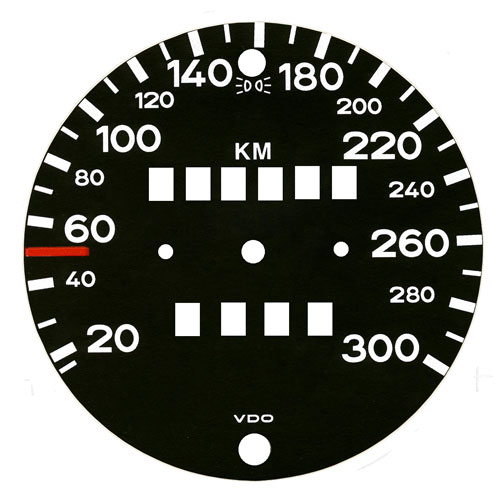 We now have metric dials and odometer gears for most Porsche Speedo's up to the late 1980's.
We now have metric dials and odometer gears for most Porsche Speedo's up to the late 1980's.
Tacho Upgrades
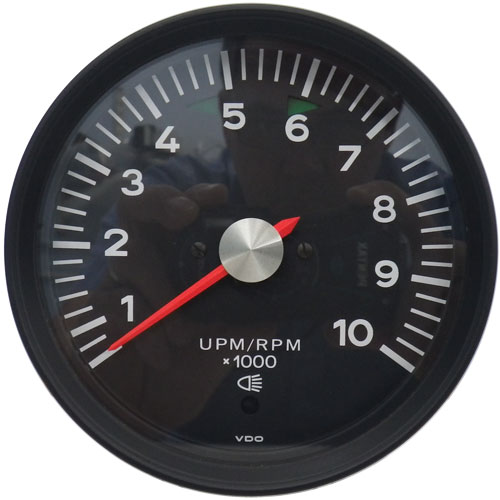
Changed your 60-70's car to electronic ignition?
We can help make your tacho work again.

 View Cart
View Cart
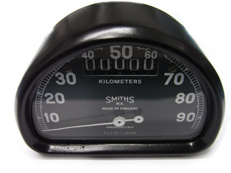
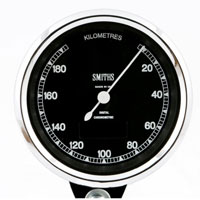
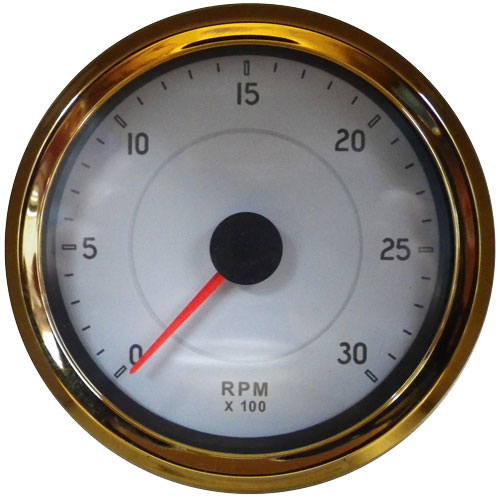
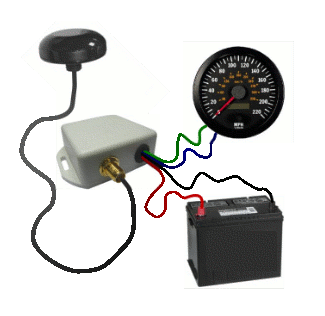
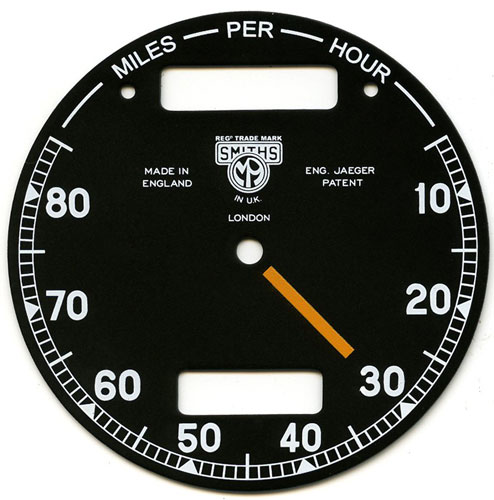
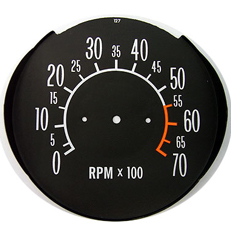
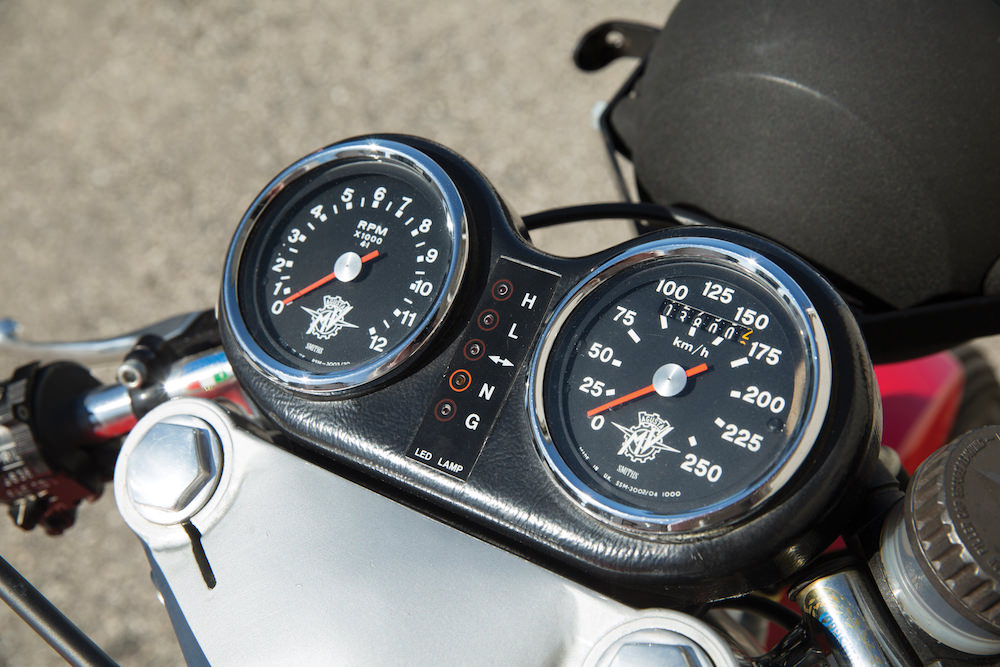
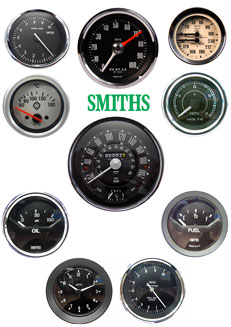
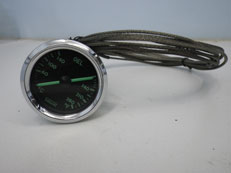
.jpg)